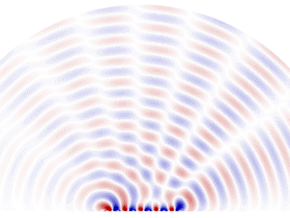
Back مصفوفة طورية Arabic فاز آراشدیران رادار AZB Фазирана антенна решетка Bulgarian Antena de matriu de fase Catalan Phased-Array-Antenne German Antenas en fase Spanish آرایه فازی Persian Antenne réseau à commande de phase French מערך מופע HE Fázisvezérelt antennarács Hungarian
This article may be too technical for most readers to understand. (March 2024) |


In antenna theory, a phased array usually means an electronically scanned array, a computer-controlled array of antennas which creates a beam of radio waves that can be electronically steered to point in different directions without moving the antennas.[1][2][3][4][5][6][7][8][9][10][excessive citations] The general theory of an electromagnetic phased array also finds applications in ultrasonic and medical imaging application (phased array ultrasonics) and in optics optical phased array.
In a simple array antenna, the radio frequency current from the transmitter is fed to multiple individual antenna elements with the proper phase relationship so that the radio waves from the separate elements combine (superpose) to form beams, to increase power radiated in desired directions and suppress radiation in undesired directions. In a phased array, the power from the transmitter is fed to the radiating elements through devices called phase shifters, controlled by a computer system, which can alter the phase or signal delay electronically, thus steering the beam of radio waves to a different direction. Since the size of an antenna array must extend many wavelengths to achieve the high gain needed for narrow beamwidth, phased arrays are mainly practical at the high frequency end of the radio spectrum, in the UHF and microwave bands, in which the operating wavelengths are conveniently small.
Phased arrays were originally conceived for use in military radar systems, to steer a beam of radio waves quickly across the sky to detect planes and missiles. These systems are now widely used and have spread to civilian applications such as 5G MIMO for cell phones. The phased array principle is also used in acoustics, and phased arrays of acoustic transducers are used in medical ultrasound imaging scanners (phased array ultrasonics), oil and gas prospecting (reflection seismology), and military sonar systems.
The term "phased array" is also used to a lesser extent for unsteered array antennas in which the phase of the feed power and thus the radiation pattern of the antenna array is fixed.[8][11] For example, AM broadcast radio antennas consisting of multiple mast radiators fed so as to create a specific radiation pattern are also called "phased arrays".
- ^ Brown, Arik D. (2021). Active Electronically Scanned Arrays: Fundamentals and Applications. Wiley-IEEE Press. ISBN 978-1-119-74905-9.
- ^ Brown, Arik D. (2012). Brown, Arik D. (ed.). Electronically Scanned Arrays: MATLAB Modeling and Simulation, 1st Ed. CRC Press. doi:10.1201/b12044. ISBN 9781315217130.
- ^ Milligan, Thomas A. (2005). Modern Antenna Design, 2nd Ed. John Wiley & Sons. ISBN 0471720607.
- ^ Balanis, Constantine A. (2015). Antenna Theory: Analysis and Design, 4th Ed. John Wiley & Sons. pp. 302–303. ISBN 978-1119178989.
- ^ Stutzman, Warren L.; Thiele, Gary A. (2012). Antenna Theory and Design. John Wiley & Sons. p. 315. ISBN 978-0470576649.
- ^ Lida, Takashi (2000). Satellite Communications: System and Its Design Technology. IOS Press. ISBN 4274903796.
- ^ Laplante, Phillip A. (1999). Comprehensive Dictionary of Electrical Engineering. Springer Science and Business Media. ISBN 3540648356.
- ^ a b Visser, Hubregt J. (2006). Array and Phased Array Antenna Basics. John Wiley & Sons. pp. xi. ISBN 0470871180.
- ^ Golio, Mike; Golio, Janet (2007). RF and Microwave Passive and Active Technologies. CRC Press. p. 10.1. ISBN 978-1420006728.
- ^ Mazda, Xerxes; Mazda, F. F. (1999). The Focal Illustrated Dictionary of Telecommunications. Taylor & Francis. p. 476. ISBN 0240515447.
- ^
 This article incorporates public domain material from Federal Standard 1037C. General Services Administration. Archived from the original on 2022-01-22. (in support of MIL-STD-188). Definition of Phased Array Archived 2004-10-21 at the Wayback Machine. Accessed 27 April 2006.
This article incorporates public domain material from Federal Standard 1037C. General Services Administration. Archived from the original on 2022-01-22. (in support of MIL-STD-188). Definition of Phased Array Archived 2004-10-21 at the Wayback Machine. Accessed 27 April 2006.